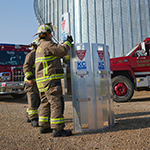Guardians of the Road: How different dash cam types enhance safety and aid in accident investigations
Dash cameras (dash cams) have become a standard fleet-management tool for larger fleets but can be extremely beneficial for any size fleet. There are 2 primary reasons a business should outfit its entire fleet with dash cams: accident documentation and driver improvement and safety management.
Determining what happened and who is at fault in an accident is often difficult and time-consuming, even for experienced law enforcement or accident investigation professionals. Dash cam video can assist in the following ways:
- Forward, road-facing dash cam video can show exactly what happened, settling conflicting and inconsistent information.
- Driver-facing cameras can indicate if there were any contributing factors to the incident related to the driver or passengers, such as distracted driving.
Video evidence regularly results in a more exact determination of fault and liability, a reduction in investigation and legal costs and a timelier resolution to a claim. Most organizations and insurers feel this is beneficial even if their driver was at fault.
Choosing the right system for your fleet
Dash cams fall into two categories: stand-alone camera, which provides accident documentation, and telematics-based systems, which add a safety management component. Several studies have found the use of telematics-based dash cam systems, in combination with driver feedback and coaching, resulted in a more than 50% reduction in unsafe driving events1.
More advanced cameras incorporate artificial intelligence capabilities. These “smart cameras” can identify poor driver behavior including:
- Distracted driving
- Fatigue
- Improper seat belt use
- Following too closely
- Rolling through a stop sign
- Cell Phone use
These items are tracked/scored like other events for management review.
Breaking down the costs
Quality stand-alone road facing cameras range from $80 to $300. Telematics-based cameras, with GPS data logging, often cost $50 to $100 more and can range from $200 to $600 per camera. These dash cameras also have a $15 to $50 monthly monitoring fee per unit. Price varies by the video quality and functionality options such as AI, in-cab coaching, internal accelerometer, motion sensors and crash detection.
References
[1] “Effective Use of Commercially Available Onboard Safety Monitoring Technologies: Guidance for Commercial Motor Vehicle Carriers,” M.C. Camden, J.S. Hickman and R.J. Hanowski, National Surface Transportation Safety Center for Excellence, Virginia Tech Transportation Institute Report 12-UT-032 (March 3, 2015).

 >
>

 >
>
 >
>